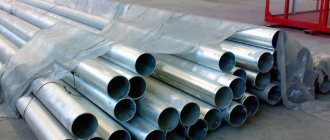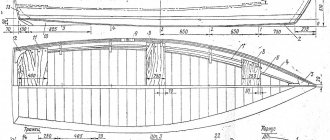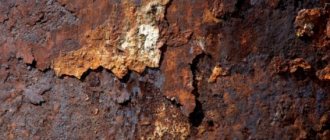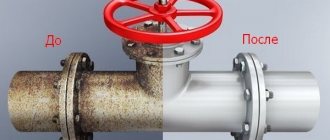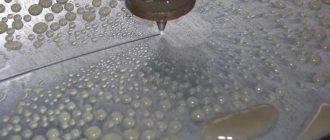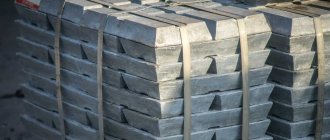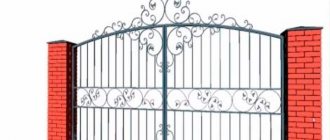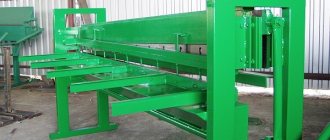Hot galvanizing is the most reliable, most effective and at the same time quite old method of protecting products from corrosive influences. Hot-dip galvanizing allows for reliable protection of the surface of metal structures from the damaging effects of the environment. A protective layer is formed on the elements, which evenly covers the parts, and its thickness ranges on average from 30 to 120 microns. A horizontal bath 13 m long, 1.8 m wide and 2 m deep makes it possible to galvanize large diameter pipes, power line supports and various metal structures. The average service life of galvanized products, depending on the conditions of their use, is 25-30 years.
Due to hot galvanizing, the coating is provided not only with a barrier, but also with electrochemical protection of the metal from corrosion. Galvanizing, which can be performed using different technologies, is used mainly in relation to steel.
In terms of cost and durability, hot zinc coating is superior to other types of galvanizing, such as electrochemical galvanizing. Hot galvanizing of metal, when compared with other technologies, is characterized by an optimal combination of the affordable cost of the technological process with the high protective properties of the resulting zinc layer. The coating applied by hot-dip galvanizing, even when the product is used in the most unfavorable conditions, can last a long time, while fully retaining its protective properties.
The essence of galvanizing
With any technology, its implementation comes down to protecting the metal from corrosion. Depending on the technique used, the protective layer can wrap the surface of the material, or additionally connect with it due to diffuse interaction.
Due to the properties of zinc, upon contact with atmospheric oxygen, an oxide film is instantly formed on its surface, which has a high density and strength, due to which it does not allow atmospheric oxygen to pass through to the metal and is not destroyed by mechanical stress.
Thus, the galvanized metal ends up in a reliable airtight shell, protecting it from destructive corrosion.
In the event of mechanical impact, the oxide film is damaged, the exposed zinc immediately interacts with atmospheric oxygen, which forms a new protective layer. Due to this property, galvanizing is called self-healing metal protection against corrosion.
Metal galvanizing methods
There are several methods of galvanizing metal, which have their own characteristics. The chosen method significantly influences, to one degree or another, the result obtained, since, depending on the scope of use of metal products and structures, it is not economically profitable to use all galvanizing technologies.
Galvanizing methods differ in the following properties:
Thickness of protective coating
— if for large metal structures the larger the layer of protection, the better, then for high-precision small parts it is necessary to use galvanizing, in which you can select and control the thickness of the anti-corrosion coating. Not every technology allows this to be realized.
Uniform thickness of galvanizing
- again, the smaller and more precise the metal part, the higher the requirements for the protective coating applied to it. For example, for a power line support, it does not matter how evenly it is covered with zinc, while for parts with holes, threads and chamfers, the uniformity of the zinc layer is extremely important.
Strength of retention of the protective coating on metal
— this parameter strongly depends on the method by which galvanizing was performed. So, for example, with hot zinc discussed below, it not only covers the surface of the product, but also connects with it at the molecular level, which significantly increases the strength of the protection on the metal.
Appearance of a galvanized part
— depending on the technology used, the surface layer of zinc oxide can be matte, glossy, and also vary in shades from dark gray to bluish.
Resistant to mechanical damage
— the higher this parameter, the longer the protection will last on products that are subjected to certain physical stress and aggressive factors.
Self-healing ability
- this ability depends on the thickness of the zinc deposited on the metal and the nature of the operation of the structure or product.
Corrosion resistance
- is a general property of a processed product, which consists of a combination of several factors. In particular, the resistance of a galvanized part to corrosion depends on the thickness of the zinc layer, its uniformity, retention strength, as well as resistance to mechanical damage and self-healing ability.
In modern industry, the most common galvanizing technologies are:
Hot
- performed by immersing the workpiece in molten zinc.
Cold
- carried out in absolute analogy with conventional painting by hand or by spraying.
Galvanic
— is implemented by immersing the workpieces in a zinc-containing electrolyte through which an electric current is passed.
Thermal diffusion
— a layer of protective coating is formed when the workpiece is placed in an environment saturated with powdered zinc.
Gas-thermal
— a gas burner is directed to the workpiece and zinc wire or zinc powder is supplied to the spot of greatest heating.
Let's look at the main advantages, disadvantages and hot-dip galvanizing technology
Do-it-yourself galvanizing
As already mentioned, some types of galvanizing can be done independently at home. This applies to cold galvanizing technology or the electrochemical method.
To perform galvanizing yourself using an electrical method, you need to carefully prepare the surface of the workpiece. Preparation includes:
- cleaning;
- degreasing;
- acid pickling;
- rinsing under running water.
You can make an apparatus for galvanic galvanizing yourself based on a direct current source with a voltage of 6-12 V at a current strength of 2-6 A and a capacitance based on a dielectric device and a device for fixing the product and electrode. Any salt solution containing zinc acts as an electrolyte. To prepare the solution, zinc is placed in a battery electrolyzer and dissolved in it. Before use, the composition is filtered.
When performing galvanizing with your own hands, you need to take into account that the following factors influence the quality and thickness of the coating:
- current density per unit area of the product;
- temperature of the electrolytic solution;
- electrolyte temperature;
- geometry and complexity of the product shape.
Galvanizing metals allows you to slow down the process of corrosion of products. Galvanizing methods depend on the operating conditions of the products. You can galvanize materials at home.
Hot galvanizing
Hot zinc coating is carried out in accordance with GOST 9.307-89 “EZSKS, Hot zinc coatings.
General requirements and control methods." Extract from GOST 9.307-89 (clause 2. Coating requirements): 2.1. Appearance of the coating
2.1.1. Upon external inspection, the surface of the zinc coating should be smooth or rough, the coating should be continuous. The color of the coating ranges from shiny silver to matte dark gray.
2.1.2. There should be no cracks, nicks, or swelling on the surface of the products.
2.1.3. The presence of zinc deposits is unacceptable if they interfere with assembly. Grains of hartzink with a diameter of no more than 2 mm, surface rippling, light gray spots and tarnished colors, scratches, scratches, traces of being caught by lifting devices without coating to the base metal are not defects.
Restoration of uncovered areas is acceptable if they are no wider than 2 cm and constitute no more than 2% of the total surface area. Uncoated areas are protected with a layer of zinc-containing paint coating (minimum thickness 90 microns, mass fraction of zinc in the dry film 80%-85%) or thermal spraying of zinc (minimum thickness 120 microns).
Degreasing
The degreasing process is very important in order to ensure that most types of contaminants are removed from the metal surface. Even if the part was delivered from production, there is a risk that various types of oils and organic compounds remain on it, which greatly negatively affect the level of adhesion.
After the product gets galvanized, the specialist assesses how heavily it is contaminated and what the nature of the contamination is. There are a large number of formulations for processing. Moreover, all of them are safe for materials - they do not cause oxidation or other undesirable reactions.
The composition can be very hot to perform degreasing. It is common to use solutions whose temperature ranges from 60 to 80 degrees. This way it is possible to achieve a noticeably better final effect. We use reagents that completely clean the surface when degreasing.
Since the method is combined with washing, it is guaranteed that all reagent residues will be removed without a trace. They will not interfere with further galvanizing of the material - this has been proven in practice.
Features of hot zinc coating
On steels with a high content of silicon and/or phosphorus (due to the heterogeneity of the chemical composition of the steel), (layers near the surface, surface structure, foreign inclusions), as well as on thick-walled products, different shades of coating are observed. The gray surface consists of a zinc-iron alloy exposed on the surface, while the lighter areas are pure zinc. In the case of steel with an unfavorable content of silicon and phosphorus, a significant thickening of the coating and a deterioration in its adhesion may occur; the visible effect of this phenomenon may be a rough surface with a gray and dark gray color, turning over time even into a brown tint.
The zinc surface on the same product may not be uniform; spots of varying degrees of gloss, gray dullness and roughness may appear. Since the surface localization of impurities in low-alloy steel leads to the fact that when rolling products from it, a significant difference appears in the content of silicon and phosphorus in different parts of the product.
However, this cannot be a defective sign, since, apart from the appearance, there are no negative aspects - it does not affect the service life of the coating, and after some time (within 1-1.5 years) the color of the structure will become the same).
White corrosion (white-gray spots that appear under the influence of atmospheric factors), as well as so-called “bloody streaks” (flux and acid residues in places of loose welding) are not grounds for claims about the quality of the galvanized surface.
The above problems are most typical for steel grade 09G2S, which is due to the peculiarities of their chemical composition.
The most common defects in the zinc coating for 09G2S steels, which are not grounds for filing claims:
1. Increased thickness of the resulting zinc coating.
2. Different thickness of zinc coating.
3. Increased formation of hard zinc.
4. Reduced adhesion of the zinc coating to the metal.
5. Reduced density of the zinc layer.
6. Appearance of the coating (lack of shine, unevenness, streaks, gray color).
Flushing
Many clients have a firmly established stereotype that contact of metal with water should not be allowed under any circumstances. Moreover, if we are talking about material that has not yet been galvanized.
Water really poses a danger to metal if it comes into contact with it for a long time. The launch of the oxidation process leads to the development of corrosion. At the same time, before galvanizing, you cannot do without washing. Only it allows you to remove all solutions and reagents that were used at the previous stage.
To improve the quality of the result, specially selected compounds are used. They are applied to the surface under pressure, and the part is carefully processed from all sides.
The equipment we install helps prepare even the most complex parts. Remains of contamination will be removed from hard-to-reach places - there will be no obstacles left for further actions.
Zinc hardness
The strength of any paint coating is determined by the strength of the binder.
Varnishes by hardness, in accordance with international standards ISO 15184, ASTM D 3363, SIS 184187, NEN 5350, ECCA Test Method, are determined using pencil leads on a scale of 6B-5B-4B-3B-B-HB-F-H-2H -3H-4H-5H-6H-7Н-8Н-9Н, where 6B is the lowest hardness and 9H is the highest hardness. It has the same hardness as a 2T pencil.
The hardness of hot-dip galvanizing is equal to the hardness of the metal. Zinc. And under zinc we have iron.
According to the Mohs jewelry scale:
Talc (graphite) - 1
Lead - 1.5 Amber (gypsum) - 2 Zinc (aluminum, gold, silver) - 2.5-3 Copper - 3 Iron - 4 Steel - 5 Glass - 6 ... Diamond - 10
Removing acid from the body
Having completed cleaning the surface from saffron milk caps, the final stage of surface cleaning begins. This galvanized treatment helps protect the metal from rotting in the future. Corrosion will not spread even in the case of through holes, because they were sealed with zinc.
The list of components required for processing included soda, and so it is needed to remove residual substances from the galvanized surface.
To do this, pour the baking soda into a container of water and mix thoroughly until completely dissolved. Next, soak a rag in the resulting solution and wipe the previously treated areas.
At the final stage, putty is applied, and then the paint is renewed; for this you can use a spray can or a brush. This procedure can also be performed at a car repair shop.
Loading…
Technological cycle of hot-dip galvanizing
A complete hot-dip galvanizing process includes the following technological steps:
Loading of products requiring processing to the hanging area
. Since the method under consideration is one of the few that allows galvanizing relatively large parts, shipment is usually carried out using special overhead cranes.
Hanging metal structures
. For subsequent processing, parts delivered to production are hung on movable crossheads. Metal structures are distributed and fixed in such a way that the entire section can fit into technological containers at further stages. It is also important to hang the products so that they can come into contact with the liquids in which they will be immersed over the entire surface, without interfering with each other.
Pre-treatment of metal structures.
Before hot galvanizing, steel products undergo mandatory multi-stage preparation. It consists of alternately immersing a traverse with suspended parts in baths with process fluids. Including, in these baths, degreasing, cleaning, etching (which ensures the penetration of zinc into the crystal lattice of the metal), removal of traces of acid, and coating with protective flux are carried out. Also at this stage, the metal is preheated before immersion in molten zinc, which avoids deformation of products due to sudden temperature changes.
Drying and preheating
. It is carried out in a special multi-stage oven into which heated and purified air is supplied. As a result, before galvanizing, traces of preliminary preparation in baths of liquids evaporate from metal structures, and they are also heated additionally.
Galvanizing
. The main technological stage of the hot-dip galvanizing process. It is carried out by transporting a traverse with prepared metal products into a furnace closed on all sides, in which a bath of molten zinc is located. Its temperature is maintained at a constant level around +450°C using high-speed gas burners. The sealing of the furnace is necessary for two reasons.
Firstly, this is necessary to ensure the safety of people who work in production. Secondly, during the galvanizing process, gases heated to a high temperature are released, which need to be purified before being released into the atmosphere. In addition, the thermal energy of these gases is used again to heat process fluids at the stage of preliminary preparation of metal products.
Removal, sorting and shipment of galvanized metal structures
. Upon completion of the galvanizing process in a bath of molten zinc, the traverse with hanging products is automatically sent to the area for their removal and sorting, after which the metal structures are loaded onto transport for shipment to the customer.
Despite the apparent complexity of the described process, the hot-dip galvanizing method is one of the simplest and most cost-effective. In addition, thanks to the introduction of certain technological stages, it is possible to ultimately obtain anti-corrosion protection with numerous advantages compared to other galvanizing methods.
Contact the specialists
Our company provides high-quality galvanizing services. The production line is equipped with all the necessary equipment to create high-quality protection against corrosion on the surface. After the specialists complete the work, it will be possible to use the material outdoors, in contact with water and various types of aggressive environments.
We pay great attention to preparation for hot-dip galvanizing. This ensures that the zinc is firmly attached to the surface and will perform all its protective functions.
We work with any types of parts.
We guarantee our clients compliance with deadlines and high quality results. To calculate the cost and get answers to other questions, leave a request on the website or call us at the numbers provided. Return to articles Share article
How to determine whether a body is galvanized or not
Most modern car manufacturers - 98% - try to galvanize the car. The type of galvanization and the degree of coating are displayed in the technical passport of the vehicle. If you purchase a car from the secondary market with significant mileage, it is almost impossible to find out whether the body is galvanized or not.
To clarify this issue, an expensive operation is needed: testing the metal using special equipment, which is only available in specialized services.
